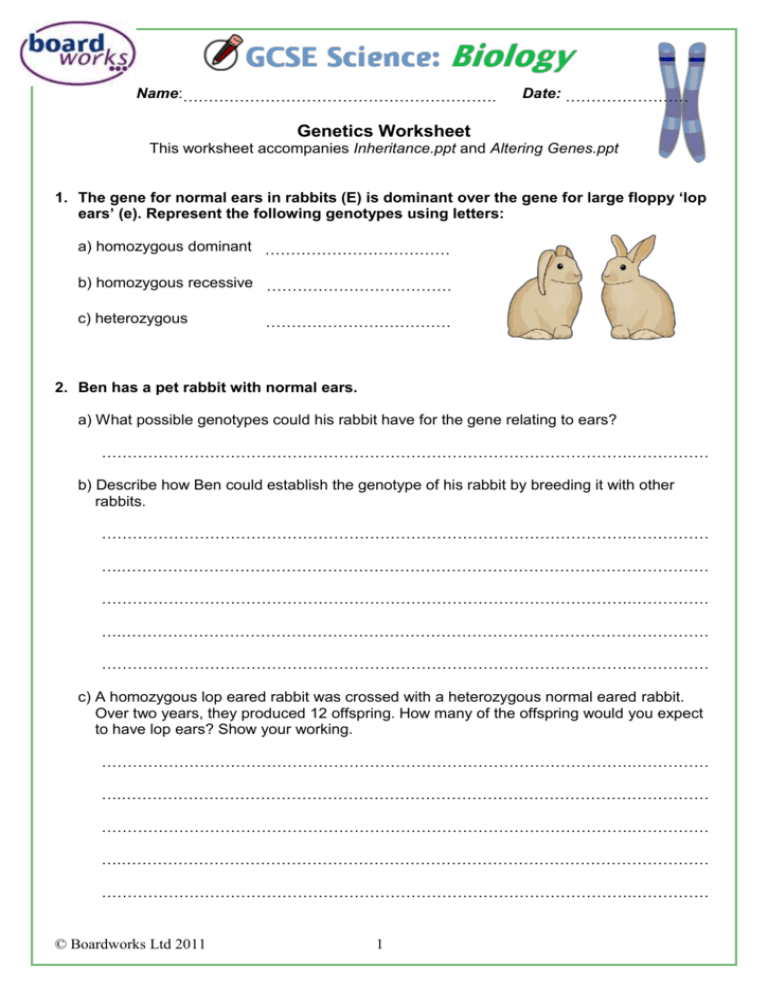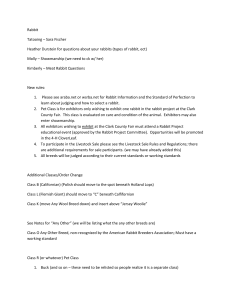Genetics Worksheet: Inheritance & Genetic Engineering
advertisement

Name:……………………………………………………. Date: …………………… Genetics Worksheet This worksheet accompanies Inheritance.ppt and Altering Genes.ppt 1. The gene for normal ears in rabbits (E) is dominant over the gene for large floppy ‘lop ears’ (e). Represent the following genotypes using letters: a) homozygous dominant ……………………………… b) homozygous recessive ……………………………… c) heterozygous ……………………………… 2. Ben has a pet rabbit with normal ears. a) What possible genotypes could his rabbit have for the gene relating to ears? ………………………………………………………………………………………….…………… b) Describe how Ben could establish the genotype of his rabbit by breeding it with other rabbits. ………………………………………………………………………………………….…………… ….…………………………………………………………………………………………………… ………………………………………………………………………………………….…………… ….…………………………………………………………………………………………………… ………………………………………………………………………………………….…………… c) A homozygous lop eared rabbit was crossed with a heterozygous normal eared rabbit. Over two years, they produced 12 offspring. How many of the offspring would you expect to have lop ears? Show your working. ………………………………………………………………………………………….…………… ….…………………………………………………………………………………………………… ………………………………………………………………………………………….…………… ….…………………………………………………………………………………………………… ………………………………………………………………………………………….…………… © Boardworks Ltd 2011 1 Name:……………………………………………………. rabbit A rabbit B rabbit C Date: …………………… rabbit D EE 3. Identify the genotypes of: a) Rabbit A ……………………………… b) Rabbit B ……………………………… c) Rabbit C ……………………………… 4. Draw a Punnett Square for the cross between rabbit C and rabbit D. © Boardworks Ltd 2011 2 Name:……………………………………………………. Date: …………………… 5. Answer the following questions about genetic engineering and selective breeding. a) Complete the following sentences using the words in the box below. Genetic engineering is a process in which selected genes are transferred from one ……………………… to another. The aim of genetic engineering is to change the ……………………… of a living organism in order to change its …………………………. For example, bacteria can be ………………………… to produce human …………………………. Selective breeding is a process where people try to improve plants and animals by selecting and breeding only those that have ……………………… characteristics. insulin DNA genetically modified characteristics organism desirable b) Give an example of how humans might want to ‘improve’ a cow by selective breeding. ………………………………………………………………………………………….…………… ………………………………………………………………………………………….…………… c) Give one way humans can genetically engineering a plant or crop to their advantage. ………………………………………………………………………………………….…………… ………………………………………………………………………………………….…………… d) List the four stages of genetic engineering. stages 1 2 3 4 © Boardworks Ltd 2011 3 Name:……………………………………………………. Date: …………………… e) Give two reasons why bacteria are genetically engineered to produce useful chemicals. ………………………………………………………………………………………….…………… ………………………………………………………………………………………….…………… ………………………………………………………………………………………….…………… ………………………………………………………………………………………….…………… 6. Answer the following questions about transgenics. a) What is transgenics and why is its useful for humans? Use the following terms in your answer: DNA, specific tissue, protein, genetic engineering, human diseases. ………………………………………………………………………………………….…………… ………………………………………………………………………………………….…………… ………………………………………………………………………………………….…………… ………………………………………………………………………………………….…………… ………………………………………………………………………………………….…………… ………………………………………………………………………………………….…………… b) Give two advantages of this method. ………………………………………………………………………………………….…………… ………………………………………………………………………………………….…………… 7. Complete one of the tasks below. a) Imagine you are a farmer interested in genetically modifying your crops. Write a press release to the local newspaper explaining the benefits of GM crops. b) Imagine you are a member of Greenpeace and you are very concerned about GM crops. Design a poster focusing on the drawbacks of GM crops. © Boardworks Ltd 2011 4




